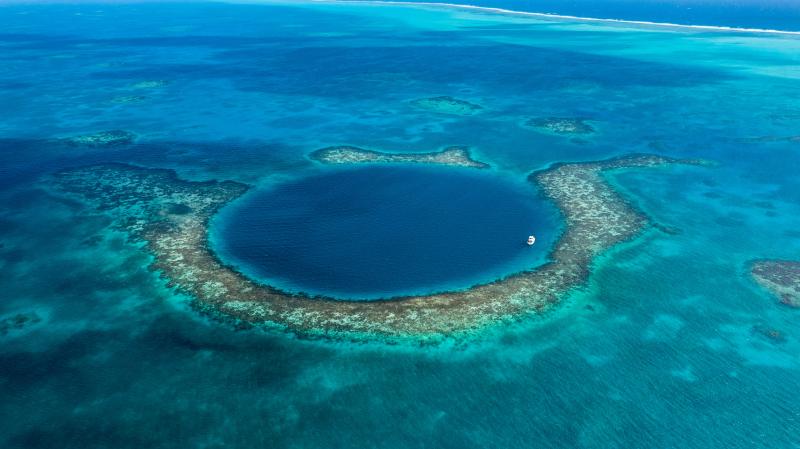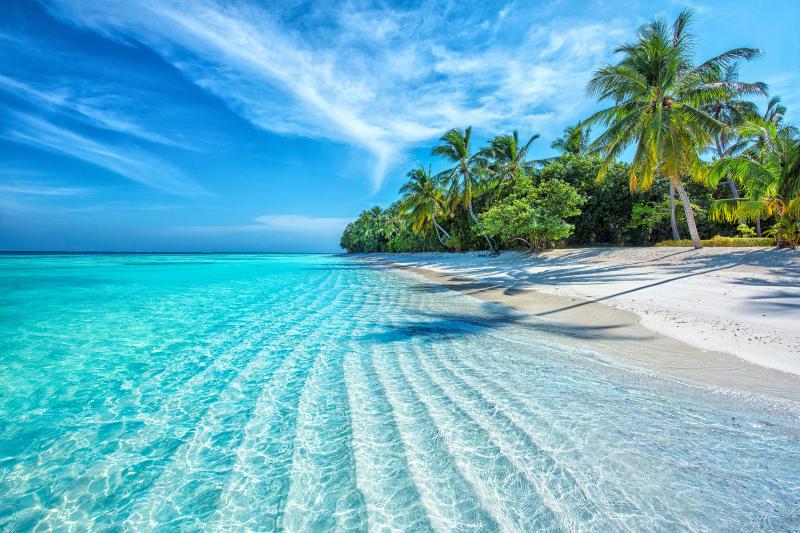View It
Visit It
Blue Hole
Belize
Visit Blue Hole
The Blue Hole, often referred to as the Great Blue Hole, is a stunning natural wonder located off the coast of Belize. This giant marine sinkhole lies near the center of Lighthouse Reef, a small atoll 70 km from the mainland and Belize City. The hole is circular in shape, over 300 meters (984 feet) across and 125 meters (410 feet) deep. The Blue Hole was originally a limestone cave that started forming about 150,000 years ago. Geologically speaking, it was created during several episodes of quaternary glaciation when sea levels were much lower. As the ocean began to rise again, the cave was flooded, and its roof collapsed, forming this spectacular submarine sinkhole.
Visiting the Blue Hole is a dream come true for many scuba divers and snorkelers due to its crystal-clear waters and its rich marine life. The array of bizarre stalactites and limestone formations more than 100 feet below the surface are a mesmerizing sight. Divers often encounter a variety of reef sharks, including Caribbean reef sharks and hammerheads, as well as other large fish like grouper and tuna that make their way into the hole. The sheer walls of the Blue Hole make it a haven for these species and provide a unique ecosystem rarely seen anywhere else in the world.
For those who prefer to stay above the water, the surrounding Lighthouse Reef offers some of the most beautiful and pristine coral reefs in the Caribbean. Boating and aerial tours are also available, providing spectacular views of the Blue Hole from above. These tours offer a different perspective of this massive blue expanse surrounded by the dark blue ocean, creating a breathtaking contrast that is a favorite for photographers and nature lovers alike.
Whether you're an avid diver looking to explore the depths of the Blue Hole or a traveler eager to witness its beauty from a boat or plane, visiting this iconic location is an unforgettable experience. The surrounding reefs and islands also offer opportunities for fishing, bird watching, and simply relaxing on beautiful beaches, making a trip to the Blue Hole a comprehensive adventure into nature’s most impressive marine wonders.
Blue Hole Monthly Weather Conditions
LOW
TEMP
HIGH
TEMP
DAYS OF PRECIP.
January
68°F
76°F
12
February
68°F
76°F
12
March
68°F
76°F
April
64°F
76°F
12
May
68°F
76°F
12
June
68°F
76°F
7
July
68°F
104°F
5
August
68°F
86°F
5
September
66°F
86°F
12
October
68°F
76°F
12
November
66°F
76°F
12
December
68°F
66°F
12
Need to Know Before You Go To Blue Hole
Find your Next Adventure in Blue Hole
Explore Blue Hole
- Deepest and Largest: The Great Blue Hole in Belize is one of the largest and deepest ocean sinkholes in the world, measuring 318 meters (1,043 feet) across and 124 meters (407 feet) deep.
- Discovery by Jacques Cousteau: It was made famous by French explorer Jacques Cousteau, who declared it one of the top scuba diving sites in the world in 1971.
- Formation: The Great Blue Hole formed as a limestone cave during the last ice age when sea levels were much lower. As the ocean began to rise, the cave flooded and eventually collapsed, creating a vertical cave in the ocean.
- Stalactites and Stalagmites: Divers can find massive stalactites and stalagmites in the Blue Hole, some of which are over 15 meters (49 feet) long, indicating its origin as a dry cave system.
- Rich Marine Life: Despite its dark, eerie waters, the Blue Hole is surrounded by an abundance of marine life, including tropical fish, reef sharks, and occasionally hammerheads and bull sharks.
- UNESCO World Heritage Site: The Belize Barrier Reef Reserve System, which includes the Great Blue Hole, was designated a UNESCO World Heritage Site in 1996.
- Research and Exploration: In 2018, a team led by Richard Branson and Fabien Cousteau conducted a submarine expedition to map the Blue Hole’s interior, revealing new details about its depth and structure.
- Ancient Maya Relics: The surrounding areas and the nearby Lighthouse Reef have been found to contain ancient Maya relics, suggesting the indigenous people might have used these waters.
- Sinkhole Science: Studies of the Blue Hole’s sediment provide valuable insights into Earth’s historical climate changes, including the reasons behind the ice ages.
- Tourist Attraction: Despite its remote location, the Great Blue Hole attracts thousands of adventurous tourists and divers every year, drawn by its mystery and natural beauty.
Featured Picture Gallery

Snorkeling is a Common Adventure to do at Blue Hole

Discovery Channel ranked Blue Hole as Number One in The 10 Most Amazing Places on Earth
Explore Similar Locations
Maldives

Turks & Caicos

British Virgin Islands

Bora Bora

